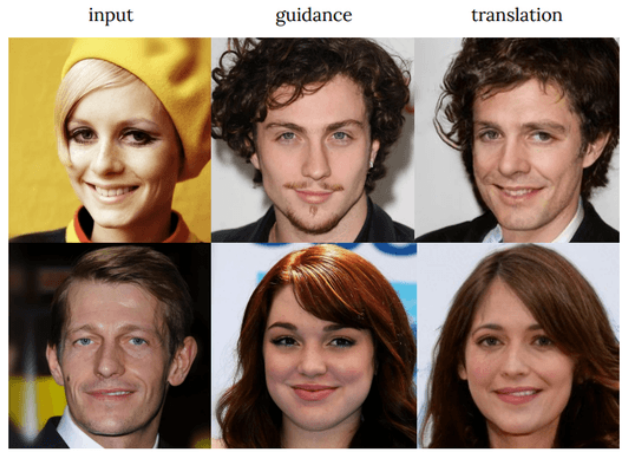We propose a protocol for evaluation of disentanglement quality of unsupervised many-to-many image translation (UMI2I) methods. We show that modern UMI2I methods fail to correctly disentangle the domain-specific from shared factors and mostly rely on their corresponding inductive biases to determine which factors should be changed after translation.
Dina Bashkirova, Ben Usman, Kate Seanko
Winter Conference on Applications of Computer Vision (WACV) 2022
arxiv / bib / data
Given an input image from a source domain and a guidance image from a target domain, unsupervised many-to-many image-to-image (UMMI2I) translation methods seek to generate a plausible example from the target domain that preserves domain-invariant information of the input source image and inherits the domain-specific information from the guidance image. For example, when translating female faces to male faces, the generated male face should have the same expression, pose and hair color as the input female image, and the same facial hairstyle and other male-specific attributes as the guidance male image. Current state-of-the art UMMI2I methods generate visually pleasing images, but, since for most pairs of real datasets we do not know which attributes are domain-specific and which are domain-invariant, the semantic correctness of existing approaches has not been quantitatively evaluated yet. In this paper, we propose a set of benchmarks and metrics for the evaluation of semantic correctness of these methods. We provide an extensive study of existing state-of-the-art UMMI2I translation methods, showing that all methods, to different degrees, fail to infer which attributes are domain-specific and which are domain-invariant from data, and mostly rely on inductive biases hard-coded into their architectures.
Please download proposed dataset splits from google drive. For the SynAction split we provide original images, for CelebA and Shapes3D we provide image ids that can be used to generate splits from original datasets: img_align_celeba.zip for CelebA, 3dshapes.h5 for Shapes3D.
# generating a custom Shapes3D split
$ ls ./corr_data_gen/shapes3d
A.txt B.txt
$ python shapes/generate_dataset.py \
--h5_path ~/Downloads/3dshapes.h5 \
--split_file_dir ./corr_data_gen/shapes3d \
--output_folder ./corr_data_gen/generated/shapes3d
$ ls ./corr_data_gen/generated/shapes3d
A B
# generating a custom CelebA split
$ ls ./corr_data_gen/celeba
A.txt B.txt
$ unzip ~/Downloads/img_align_celeba.zip
$ ls img_align_celeba/ | wc -l
202599
$ for dom in A B; do \
mkdir -p ./corr_data_gen/generated/celeba/${dom}; \
cat ./corr_data_gen/celeba/${dom}.txt | while read line; do \
cp ./img_align_celeba/${line} ./corr_data_gen/generated/celeba/${dom}; \
done; done
$ ls ./corr_data_gen/generated/celeba/
A B
- python 3.8+
- Tensorflow 2.2
- pillow 8.1
You can find the checkpoints for the attribute prediction models here.
To predict the attributes of the translation examples in a particular folder, please use the following command. Please note that all translation images
must be named in the format contentname_guidancename_.png, e.g., 0123_4567_.png if it was translated from content image 0123.png with the guidance image 4567.png.
Here is an example for the attribute prediction of a method trained on the 3DShapes dataset:
python shapes/predict_dshapes.py \
--data_dir /path/to/translation/results/ \
--out_file ./translation_attrs.txt \
--ckpt_dir /path/to/corresponding/checkpoints/
Alternatively, the attribute predictors can be trained from scratch with the following command:
python shapes/predict_dshapes.py \
--data_dir /path/to/translation/results/ \
--out_file ./translation_attrs.txt \
--ckpt_dir /path/to/corresponding/checkpoints/ \
--train_predictors True --train_data /path/to/original/images/ \
--train_attributes /path/to/GT/attributes.txt
For Synaction attribute prediction, you need to specify the files containing the predicted body poses as well. So, for Synaction, the command should look like:
python synaction/predict_synaction.py \
--data_dir /path/to/translation/results/ \
--out_file ./translation_attrs.txt \
--ckpt_dir /path/to/corresponding/checkpoints/ \
--original_poses_file /path/to/original/data/poses/file.txt \
--translated_poses_file /path/to/translated/data/poses/file.txt
To predict the poses for all images in a given folder for Synaction, please use the following command:
python synaction/detect_pose_folder.py '/path/to/images/*.png' /output/poses/file.txt
For a given attribute prediction file, please use the following command to compute the image translation metrics:
python compute_metrics.py \
--method_attr_file /path/to/predicted/attributes.txt \
--original_attr_file DATASET/original_attributes.txt \
--out_file DATASET/metrics.txt \
--dataset DATASET
where DATASET can be one of shapes, synaction, celeba. For example, for the 3DShapes experiment with DRIT++ and the precomputed attributes in shapes/drit_attrs.txt, the command will be:
python compute_metrics.py \
--method_attr_file shapes/drit_attrs.txt \
--original_attr_file shapes/original_attributes.txt \
--out_file shapes/drit_metrics.txt \
--dataset shapes
If you find our work useful, please consider citing
@inproceedings{bashkirova2022evaluation,
author = {Bashkirova, Dina and Usman, Ben and Saenko, Kate},
title = {Evaluation of Correctness in Unsupervised Many-to-Many Image Translation},
booktitle = {Proceedings of the IEEE/CVF Winter Conference on Applications of Computer Vision (WACV)},
month = {January},
year = {2022},
pages = {1776-1785}
}
